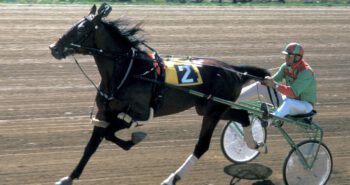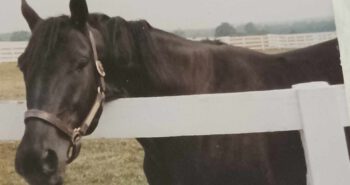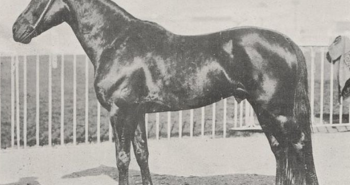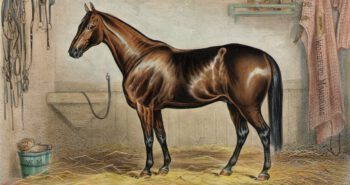A supremely fast trotter, he is most famous for stumbling shortly ahead of the wire in the Hambletonian with victory within reach. Sold to Europe not long after equaling a world record at 4, Brown Berry later likely became a clandestine stallion in France.
Brown Berry was named for his two former owners, Thomas Berry and Lawrence Brown, trainer and superintendent, respectively, at Hanover Shoe Farms. The duo had bought the brown colt from the estate of WL Handy, but sold him at the 1931 Old Glory auction, where he was bought by J Irvin Lyle, president of the Central New Jersey Horsemen’s Association, for $3,000.
Talented but erratic
He proved himself early, winning the two-year-old trot in Toledo on Jul 15, 1932. In the Goodtime Stake at Goshen he was up against the undefeated Spencer McElwyn. However, Brown Berry easily won the first heat in 2:07 1/2 (1.19,2), but was, peculiarly, distanced in the second. That meant Hollyrood Portia, winner of the second heat, won on a sort of knock-out: under the rules at the time, only heat winners were allowed to start after the second heat, but as Brown Berry had been distanced he was automatically out of the race.
In the Illinois State Futurity, in Springfield on Aug 25, Brown Berry finished fourth after a being 4-2 in the two heats. In the second heat Brown Berry showed his tremendous speed when he and Mary Reynolds raced the first quarter in 29 1/2, the half in 1:00 1/2. Spencer McElwyn was too strong and won in 2:04 1/2 (1.17,4), but Brown Berry was not far behind. The colt further underlined his credentials by winning the first heat, after leading the whole race, in the Horseman Futurity at Indianapolis two weeks later. In the second heat he again took the lead, but broke stride and finished third.
After just a few starts, Brown Berry was seen as one of the best ones in the crop, but with clear weaknesses: “Brown Berry, beaten in his last three starts, still must be rated a high class colt, but with a weakness; he is a front runner, does not take kindly to trailing and this caused his defeat both at Springfield and Indianapolis. In both races he was “run down” by Mary Reynolds, Sir Raleigh winning the first, Spencer McElwyn the second.”
One of only four starters in the Junior Kentucky Futurity on Sep 19, Brown Berry finished third behind Spencer McElwyn and Mary Reynolds. Despite not winning, Brown Berry looked good. According to the Lexington Herald-Leader, “though not heat winners, both Brown Berry and Meurice were contenders. And this was especially true of Brown Berry. His ankles were troubling him but he put up a good race. The colt was the object of much local interest as he is the property of a former Fayette county boy, J Irvin Lyle, Newark, NJ, and driven by Fred Egan, who has made Lexington his main base of operations for the last two or three years. Egan is enthusiastic over the colt’s prospects for another year as he thinks this trouble can be corrected by that time.”
One of the winter favorites
Over the winter break, Brown Berry was considered one of the winter favorites for the upcoming Hambletonian. According to an article in numerous newspapers, “this colt, a son of Peter Volo, probably had as much speed as any two-year-old which raced the past season but his manners only handicapped him. He didn’t race so well in the bunch but wanted to have the race track to himself, off in front. Had he possessed the manners of Spencer McElwyn or Mary Reynolds, he would probably have won both the Good Time Stake and the Futurity at Lexington. He has the speed and he is game, if he gets over his breaking habits he will be hard to handle.”
Making his debut in the Matron Stakes at Toledo on Jul 1, 1933, Brown Berry finished second after 2-2-4 in three heats, Spencer McElwyn winning after 7-1-1 in the three heats. Going to the North Randall track in Cleveland, Brown Berry finished 3-2-3 and was third overall in the Championship Stallion Stake, losing to the mares Mary Reynolds and Hollyrood Portia. Despite losing, it wasn’t all gloom as Brown Berry’s manners had clearly improved from his 2-year-old season.
This was evident in the American Stake at Rockingham Park on Aug 2. Sitting pretty in fifth until the last turn, Brown Berry put in a good finish, losing only to favorite Mary Reynolds. With the latter the overwhelming favorite, Brown Berry was not to be denied in the next two heats. In the second, he flew down the final stretch to win by half a length ahead of Mary Reynolds in 2:04 3/4 (1.17,5), while in the third he won from the front in 2:05 3/4 (1.18,2). Considered a longshot in the Hambletonian after his early season performances, Brown Berry’s win in the American Stake, just two weeks prior to the big race, suddenly made him one of the serious Hambletonian-contenders. The favorite, though, was the spectacular Mary Reynolds, who underlined her credentials with a win the National Stake on Aug 9, the dress rehersal for the Hambletonian a week later. In that race, Brown Berry was 2-2-3 to finish third behind Mary Reynolds and Calumet Delco, the latter winning the frst heat.
The stumble at Goshen
Drawing post 3, Mary Reynolds had the luck of the Hambletonian draw – Brown Berry did not, getting 11 and starting in the second tier. Brown Berry’s luck would get worse, though.
In the first heat, Mary Reynolds went to the lead shortly after the quarter and won relatively easily with Brown Berry three lengths behind. In the second heat Brown Berry took the lead early while Mary Reynolds made a short break after rounding the first turn. The filly was driven aggressively to the lead but down the final stretch Brown Berry managed to sneak past on the inside, winning by a nose.
In the third and final heat, Brown Berry was quickly moved to the front ahead of Hollyrood Portia and Mary Reynolds. From the New York Times, “As the horses rounded the final turn, the tenseness increased. Filly and colt, favorite and second choice, were in the van battling desperately. Three-sixteenths of a mile stretched in front of the pair and all eyes were strained on them. Now the excited roar was continuous. Brown Berry on the pole drew into the lead. Mary Reynolds out near the middle of the track responding to Ben White’s urging. Then came a near tragedy. Just at the moment when Brown Berry seemed a sure winner, he stumbled and dropped to his knees. Egan, losing his balance, almost fell out of his sulky and the reins slipped from his grasp.
However, Brown Berry in a flash regained his feet and his stride. Egan, leaning over, gathered up the reins and had the colt in his stride as they passed the winning post. It was too late, though, and Mary Reynolds took the laurels.”
Ben White then “dismounted and, as Fred Egan crossed the track, Ben put an arm about the shoulders of the man who, but for the near-accident, might have had his name go down on the record as the winner of the eighth Hambletoinan Stake.”
Most reports from the day, reported that Egan went to the ground as well, albeit was back in the sulky almost instantly. According to the New York Herald Tribune, “Egan was jolted to the ground between the colt’s hocks and the sulky, but he held the reins in his left hand and scrambled back to his seat by the time Brown Berry had got up.”
By getting up and trotting to the finish line, Brown Berry finished 2-1-11, thus ensuring himself second place and $7,400 prize money. It would have been close to $21,000 more, however, had he won the race. But what would have happened had he stayed trotting? The writers present were divided. The Middletown Times Herald wrote that “experts agree falter in the final heat did not change final standing” and another report humorously made the point by writing “Brown Berry wouldn’t have won, however, for Mary Reynolds was less than a head behind and coming like a gazelle late for a date with his gal.” However, The Daily News headline read “Stumble cost Brown Berry Hambletonian”, while the Evening Sun summed it up with “may have cost colt victory.” The latter newspapers added that “opinions differ as to whether the fall cost Brown Berry the race. Many persons who witnessed the event believe that he otherwise would have won. The rich stake went to Mary Reynolds, owned by William N Reynolds, Winston-Salem, NC. Lawrence Brown, one of Brown Berry’s former owners, who witnessed the Hambletonian, has arrived home. He told the Evening Sun today that he firmly believes Brown Berry would have won the rich event had he not fallen. He pointed to the fact that, while Mary Reynolds was gaining on the colt at the time, she was under a drive. Fred Egan had not yet used his whip on Brown Berry.” The crown was equally divided. After the race, Egan, after turning Brown Berry over to his groom, “walked up the stretch and received a whole-hearted ovation from grandstand, bleachers and rail.”
Fred Egan later described the experience from his point of view. In the Evening Sun on May 14, 1950, Egan stated: “I fell off the seats and down between the shafts, hanging on by my elbows with the seat of my britches almost dragging in the dirt. My first thought was to drop under the sulky and let the horse go, but when I glanced back and saw that mob of horses bearing down on me I realized I couldn’t do that. Somehow, I managed to get both legs over one side of the shaft and finished the race riding sort of side-saddle. It was the damndest experience I ever had and how I managed to hoist myself into that position I’ll never know, but I’m not curious enough to want to try it again.”
Rebounding impressively
It would not have been surprising if the stumble in the Hambletonian ruined the rest of Brown Berry’s season. However, the colt proved much tougher than that. Two weeks later, in the first Grand Circuit race after the Hambletonian, he and Mary Reynolds met again in the Horseman Futurity. This time, the outcome was never in doubt as Brown Berry won in two straight heats in 2:03 1/2 and 2:03 1/4 (1.16,8 and 1.16,6).
Yet another showdown between the duo, in the Kentucky Futurity, was canceled as Mary Reynolds was lame and had to be scratched. Oddly enough, her stablemate Meda rose to the occasion and who in straight heads. Brown Berry had an off-day and finished fourth overall after 3-3 placings.
As the season wrapped up, Brown Berry was the fastest trotting colt of his year with the 2:03 1/4 (1.16,6) clocking in the Horseman Futurity. While the European’s had started to buy up the best American three-year-olds, Brown Berry and Mary Reynolds did you leave the home country – yet. However, Meurice, a surprise third in the Hambletonian, left for Germany at the end of 1933.
Equaling the world record
Making his seasonal debut at 4 in a free-for-all at North Randall at the end of June, Brown Berry finished fourth. A week later he was fifth at the same track. As it turned out, Brown Berry needed those two races to get ready. On Toledo, on Jul 12, he equalled the world record for four-year-old trotters. After Hollyrood Portia had won the first heat, “Egan brought Brown Berry through the stretch under a furious drive and finished in 2:01 (1.15,2) with Hollyrood Portia second. The time was the fastest of the year for trotters and ties the mark held jointly by Guy Fletcher and Calumet Bush, now campaigning in Europe, and also Vansandt. Brown Berry won the third heat in similar fashion. In each mile Calumet Crusader, Will Hudson’s heavily played favorite, took command on the backstretch but wilted when the field turned for home.”
Brown Berry had several tough duels with Vansandt Kashmary and Morley Frisco for the next two months. On Aug 31, 1934, however, it was reported that “after some negotiations the parties who purchased the brillant trotter, Brown Berry 2:01, finally agreed to Mr Lyle’s price at the Goshen meet. However, Mr Lyle took a chance that it might be cancelled by refusing the complete the transaction until Brown Berry had shown and performed as scheduled at the local meet.
The purchasing parties agreed and the deal was made at the local track, but not until Brown Berry had trotted about the Borough Park Track. However, Mr Lyle isn’t the only member of the association to show faith in the club at a possible financial loss. Other members of the club raced their horses to their limit last Saturday despite the fact that several were slated to go for the money this week.
Incidentally Brown Berry was shipped to France yesterday and Mr Lyle sat behind his horse for the last time early this week when he worked him out at the local track. It was a sad parting between Lyle and his great trotter, but he is optimistic over securing another great one in the near future.”
Ups and downs in Europe
According to an article in the Cincinnati Enquirer on Sep 2, “the purchase was made for French interests by the Connecticut horseman “Smiling Johnny” Lingua. Brown Berry won several futurities last year, including the Horseman Stake at the local track, in which he defeated the Hambletonian Stake winner, Mary Reynolds” and added that the price reportedly was $10,000.
After arriving in Le Havre, France, Brown Berry was immediately sent to Italy, where he competed in a few races without success. On Christmas Eve 1934, he started in the Premio d’Inverno but received – like the other challengers – a handsome beating from European debutant Muscletone. Brown Berry ended outside the money as the US-bred trio Topsy Hanover, Mazie Volo and Calumet Desmond finished behind the indomitable Muscletone. The Peter Volo-son didn’t fare much better in Premio Nuovo Anno on New Year’s Day 1935 and again finished out of the money. Calumet Desmond won ahead of Austria star Nervus Rerum and Atlantic Volo.
Listed as one of the probable starters in the 1935 Prix d’Amerique, Brown Berry was a late scratch after a slight injury in training. His luck improved as he was third in the Prix de New York on Feb 16, 1935, behind Filibert Jockey and Heroine B, the latter a full sister to Amazone B, after starting with a 62 meter handicap. A few months later he finally proved his abilities on French soil when he won the Prix de Bruxelles at Enghien on May 25, 1935. The American-born son of Peter Volo impressed the French horsemen when he won the 2325 meter (1,45 mile) long race in 1.20 (2:08.4), said to be the “best speed reached to date in France.” In fairness, it wasn’t: Sam Williams had trotted in 1.19,6 (2:08) at Enghien on Mar 5, 1930, but back then the French didn’t recognize records set by foreign trotters. But, regardless of this little technically Brown Berry had the French record for a few years, and his clocking certainly showed he wasn’t lacking in ability.
In fairness, Brown Berry wasn’t particularly suited to French trotting as he generally wasn’t that comfortable over the longer distances there, and he also wasn’t comfortable on wet and heavy tracks. With that in mind, this third place in the Prix de Buenos-Aires, driven by Paul Viel, in August 1935 was quite impressive. The five-year-old overcame a 75 meter handicap to finish thing, behind Hasparens and Green Kelp, but ahead of Calumet Delco. When in top form he had the ability to do well even against the very best. This happened when he finished third, behind Net Worth and Muscletone, in the Prix d’Italie on Feb 9, 1936. Brown Berry’s French career was on the whole somewhat lacking compared to the promise his US results offered. He mostly competed on a level below the highest elite and eventually retired in August 1938.
A secret daddy?
Brown Berry wasn’t eligible to stand stud in France, but there is a strong suggestion he may have been doing a little studbook, anyway. Brown Berry is strongly suspected of being the the actual sire of several trotters officially sired by Epaminondas, most notably his Criterium des 4 ans-winning son Premier Mars. The latter was described in Le Trotteur as “Premier is an attractive bay-brown horse, very racing-like and blood-like.” While the coat color was compatible with Epaminondas, he was a large, rugged colt who generally didn’t produce sleek, refined types like Premier Mars. Henk Houtman, who imported Premier Mars to the Netherlands, was very firm in his belief that Brown Berry, and not Epaminondas, was the sire. Unfortunately his knowledge of the matter is lost to history.
BROWN BERRY
Bay colt born in Lexington, KY in 1930. Died in France at unknown date.
Peter Volo – Royal Belle (Royal Watts)
4,2:01 (1.15,2)
Breeder: WL Handy
Owners: WL Handy – Thomas Berry and Lawrence Brown – J Irvin Lyle – J Larochette
Trainers: Fred Egan, Jean Bertho and F Tardivon
Drivers: Fred Egan, Jean Bertho, Molesini, Paul Viel and others
Grooms: –





